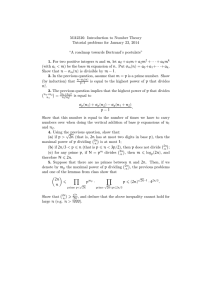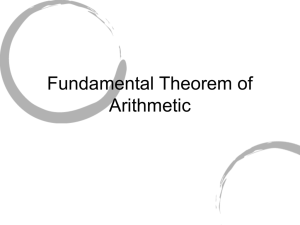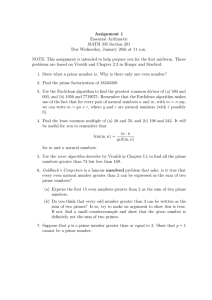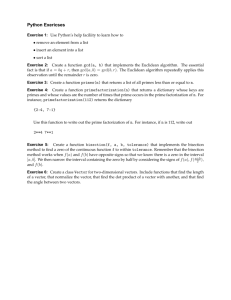Summer High School 2009 Aaron Bertram 4. Greatest Common Divisors.
advertisement
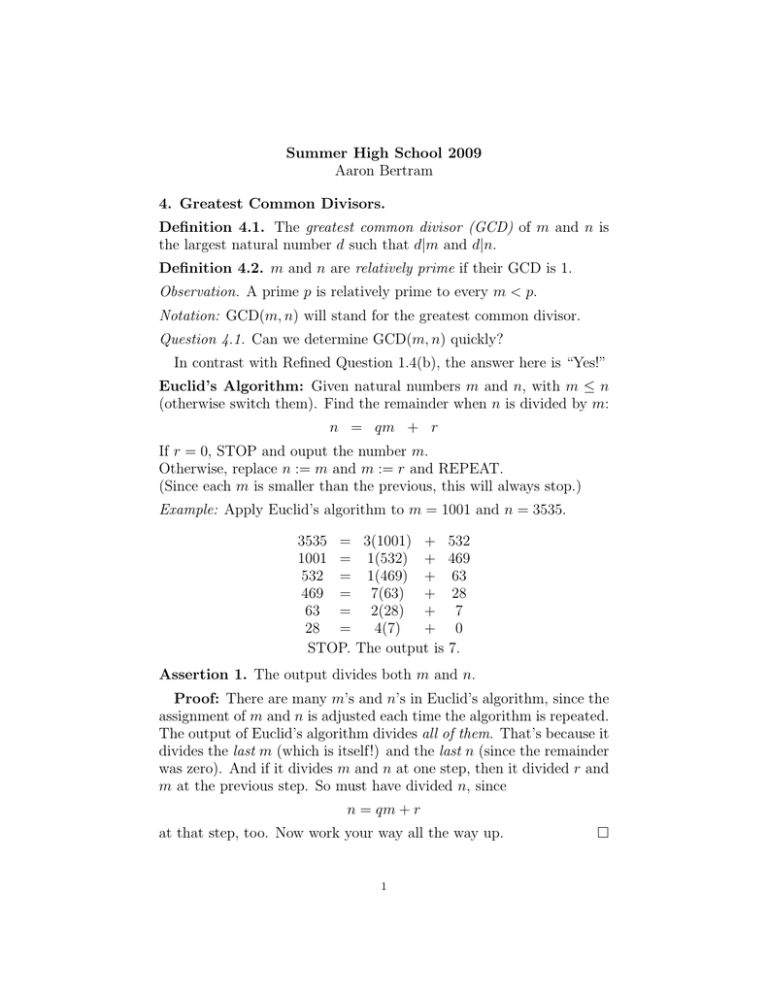
Summer High School 2009
Aaron Bertram
4. Greatest Common Divisors.
Definition 4.1. The greatest common divisor (GCD) of m and n is
the largest natural number d such that d|m and d|n.
Definition 4.2. m and n are relatively prime if their GCD is 1.
Observation. A prime p is relatively prime to every m < p.
Notation: GCD(m, n) will stand for the greatest common divisor.
Question 4.1. Can we determine GCD(m, n) quickly?
In contrast with Refined Question 1.4(b), the answer here is “Yes!”
Euclid’s Algorithm: Given natural numbers m and n, with m ≤ n
(otherwise switch them). Find the remainder when n is divided by m:
n = qm + r
If r = 0, STOP and ouput the number m.
Otherwise, replace n := m and m := r and REPEAT.
(Since each m is smaller than the previous, this will always stop.)
Example: Apply Euclid’s algorithm to m = 1001 and n = 3535.
3535 = 3(1001) + 532
1001 = 1(532) + 469
532 = 1(469) + 63
469 = 7(63) + 28
63 = 2(28) + 7
28 =
4(7)
+ 0
STOP. The output is 7.
Assertion 1. The output divides both m and n.
Proof: There are many m’s and n’s in Euclid’s algorithm, since the
assignment of m and n is adjusted each time the algorithm is repeated.
The output of Euclid’s algorithm divides all of them. That’s because it
divides the last m (which is itself!) and the last n (since the remainder
was zero). And if it divides m and n at one step, then it divided r and
m at the previous step. So must have divided n, since
n = qm + r
at that step, too. Now work your way all the way up.
1
2
Example: In the example above, 7 divides 7 and 28 (last step), so:
7 divides 63, 7 divides 469, 7 divides 532, etc.
Definition 4.2. An integer d is a linear combination of m and n if
there are integers a and b (usually one of them is negative) such that:
am + bn = d
(Notice that this is the same thing as saying that am ≡ d mod n).
Assertion 2. The output is a linear combination of m and n.
Proof: The output of Euclid’s algorithm is the remainder in the
next-to-the last step. As in the previous assertion, it is easier to see
that every n0 , m0 and r0 appearing in every step of Euclid’s algorithm
is a linear combination of m and n. This is true at the first step, since:
(0)m + (1)n = n, (1)m + (0)n = m and (−q)m + (1)n = r
Suppose it is true at one step. That is, suppose:
a1 m + b1 n = n0 , a2 m + b2 n = m0 , and a3 m + b3 n = r0
(we need “primes” on m, n, r to distinguish them from the originals)
Then the n00 , m00 and r00 of the next step are given by:
n00 := m0 , m00 := r0 and r00 = n00 + (−q 00 )m00
so n00 and m00 are linear combinations of m, n from the previous step.
What about r00 ? Well, this is exactly the situation that matrices are
designed for. If we represent the linear combinations giving m00 and n00
as the columns of a 2 × 2 matrix and multiply, we get:
a2 + a3 (−q 00 )
a2 a3
1
=
b2 + b3 (−q 00 )
b2 b3
−q 00
which is the column vector for the desired set of coefficients:
(a2 + a3 (−q 00 ))m + (b2 + b3 (−q 00 ))n = r0
Thus we can keep going.
Example: In the example above, the column vectors are (in order):
0
1
−3
4
−7
53
−113
,
,
,
,
,
,
1
0
1
−1
2
−15
32
and so, finally, (−113)(1001) + (32)(3535) = 7.
Notice how easy this is to implement in practice!
These simple assertions are remarkably important. Here are the first
few corollaries that we can draw from them:
3
Corollary 1: Every common divisor of m and n divides the output.
In particular, the output of Euclid’s algorithm is the GCD, and every
common divisor of m and n also divides their GCD.
Proof: If d divides m and n, then d divides any linear combination
of m and n. Since the output is a linear combination, it follows that
all common divisors divide the output. And of course all divisors are
smaller than the number they divide, so the output is the GCD.
Corollary 2: If GCD(m, n) = 1, then m has a reciprocal mod n. If p
is prime then each number not divisible by p has a reciprocal mod p.
Proof: If GCD(m, n) = 1, then Assertion 2 gives:
am + bn = 1 for some integers a, b
which is exactly what we require for reciprocals. And primes are relatively prime to every number that they don’t divide.
Corollary 3: Suppose p is a prime and p|(mn). Then p|m or p|n.
Proof: Suppose p doesn’t divide m. Then GCD(p, m) = 1, so:
ap + bm = 1 for some integers a and b
Now multiply this entire equation by n. This gives:
(an)p + b(mn) = n
so that n is a linear combination of p and mn. Since p divides both
of these (by assumption), it must divide n as well! In other words, p
must divide one or the other (or both) of m and n.
Corollary 4 (Fundamental Theorem of Arithmetic (Part II)):
In Part I, we saw that every natural number n is a product of primes.
This part shows that there is only one way to do this.
Proof: Suppose n = p1 p2 · · · pk is one way to write n as a product of
primes, and q is another prime that divides n. Then q|p1 (p2 · · · pk ), so
by Corollary 4.5, q|p1 or q|p2 · · · pk . If q|p1 , then q = p1 because they
are both primes. But if p divides the product of the others, then the
same argument shows that p must be one of the others. Thus q is one
of the pi . It follows that if n = q1 q2 · · · ql is another way to write n as
a product of primes, then k = l and the p’s and q’s are the same. Remark: Factoring large numbers is hard (even for a computer)! Thus,
for example, we could have factored:
1001 = 3 · 7 · 11 and 3535 = 5 · 7 · 101
and concluded that 7 was the GCD, this is actually a lot harder to do
than implementing Euclid’s algorithm! If you don’t believe me, choose
4
two very large numbers (say, 40 digits) at random. It is easy to get a
computer to run Euclid’s algorithm, but factoring them takes forever.
Definition 4.3: The Euler phi function is defined by:
φ(n) = # {numbers from 1 to n − 1 that are relatively prime to n}
Examples:
φ(p) = p − 1 if p is a prime (everything is relatively prime to p).
φ(4) = 2 (only 1 and 3 are relatively prime to 4).
φ(6) = 2 (only 1 and 5 are relatively prime to 6).
φ(8) = 4 (1, 3, 5 and 7 are relatively prime to 8).
φ(9) = 6 (1, 2, 4, 5, 7, 8 are relatively prime to 9).
φ(10) = 4 (only 1, 3, 7 and 9 are relatively prime to 10).
Two important features of the phi function make it easy to calculate:
Prime Powers: Suppose pk is a prime power. Then the numbers from
1 to pk − 1 that are relatively prime to pk are exactly the numbers that
are not divisible by p. These are p − 1 out of every p numbers:
1, 2, · · · , p − 1 from the first p numbers,
p + 1, p + 2, · · · , 2p − 1 from the next p numbers,
2p + 1, 2p + 2, · · · 3p − 1 from the next, all the way up to pk . So:
p−1 k
k
φ(p ) =
p = pk − pk−1
p
That was easy. The next feature is much more surprising:
Relatively Prime Products: Suppose m and n are relatively prime.
Then:
φ(mn) = φ(m)φ(n)
(and this is definitely NOT true if m and n are not relatively prime!)
We will see why this is true later. But first notice that these features
allow us to calculate the phi function of n provided we can factor n
(but unlike Euclid’s algorithm for GCD’s, there is no shortcut here!).
Examples:
91 = 7 · 13 so φ(91) = φ(7) · φ(13) = 6 · 12 = 72.
162 = 2 · 34 so φ(162) = φ(2) · φ(34 ) = 1 · (34 − 33 ) = 54.
144 = 24 · 32 so φ(144) = φ(24 ) · φ(32 ) = (24 − 23 )(32 − 3) = 48.

